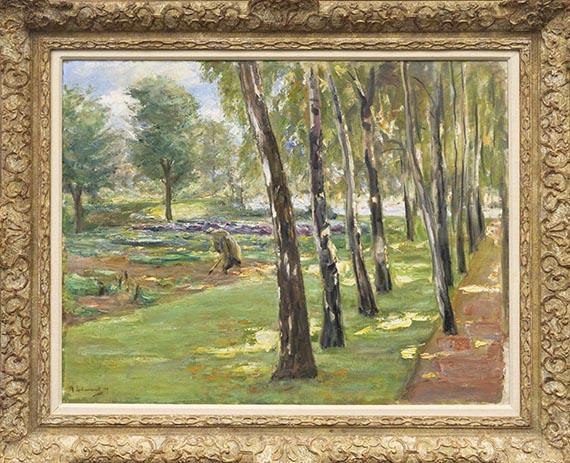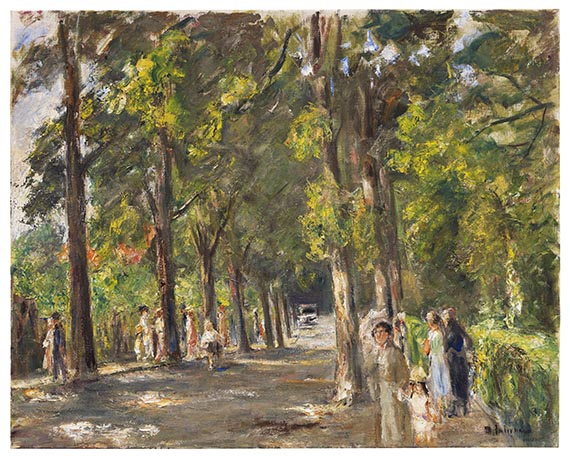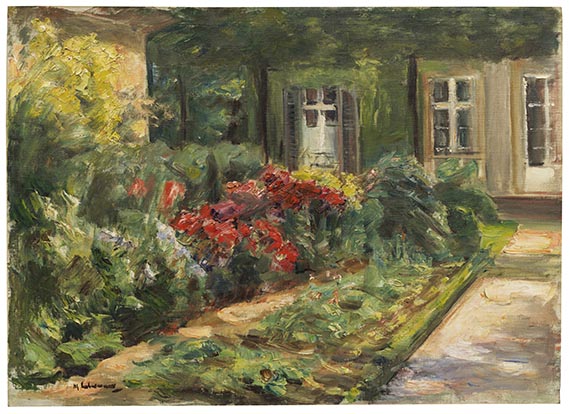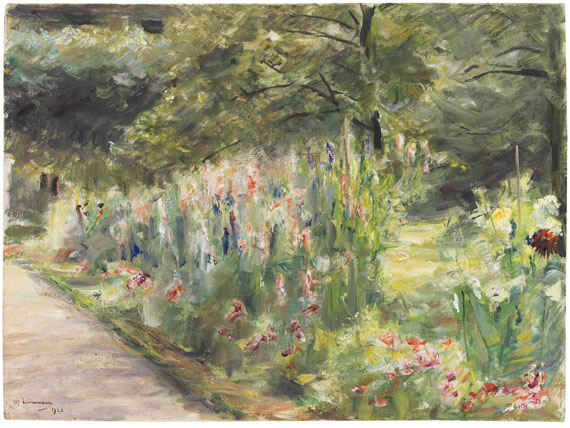9
Max Liebermann
Die Birkenallee im Wannseegarten, 1919.
Oil on canvas
Post auction sale: € 400,000 / $ 472,000
Die Birkenallee im Wannseegarten. 1919.
Oil on canvas.
Signed and dated in the lower left. 70.5 x 90.5 cm (27.7 x 35.6 in).
• The view towards the glistening waters of Lake Wannsee through the birch trees creates an accomplished symphony of light and shadow.
• After the war broke out in 1914, Liebermann's villa on the Wannsee became his artistic and private retreat.
• Liebermann reached a new level of liberation of form and color in the paintings he created here.
• The famous garden pictures are among his most sought-after works on the international art market.
• Liebermann paintings of the Birch avenue on Wansee are part of the collections of the Niedersächsisches Landesmuseum, Hanover, the Hamburger Kunsthalle, and the Nationalgalerie, Berlin.
PROVENANCE: Galerie Grosshennig, Düsseldorf.
Kunsthaus Bühler, Stuttgart (acquired from the above, probably in 1963, with the gallery's label on the stretcher).
Gabriele Zimmermann Collection (née Bühler), Stuttgart (inherited from the above in 1974).
Private collection, Berlin (acquired from the above in 1998).
EXHIBITION: Im Garten von Max Liebermann, Kunsthalle Hamburg, June 11 - September 26, 2004; Alte Nationalgalerie, Berlin, October 12, 2004 - January 9, 2005, p. 197, cat. no. 24 (illustrated on p. 137).
Max Liebermann. Der Birkenweg - Ein Motiv zwischen Impressionismus und Jugendstil, Liebermann-Villa am Wannsee, Berlin, April 27 - July 27, 2008, p. 73 (illustrated on p. 21).
LITERATURE: Matthias Eberle, Max Liebermann (1847-1935). Catalogue Raisonné of Paintings and Oil Studies, vol. II: 1900-1935, Munich 1996, p. 989, no. 1919/23 (titled “Die Birkenallee im Wannseegarten, Blick auf das Kohlfeld”, illustrated on p. 991).
- -
Martin Faass, Die Idee vom Haus im Grünen. Max Liebermann am Wannsee, Berlin 2010, p. 148 (with full-page illustration).
“I love the way you can see a tree trunk growing out of the ground. It lends its form a whole different kind of intensity.”
Max Liebermann to Gotthard Jedlicka, quoted in: Gloria Köpnick and Rainer Stamm (eds.), Max Liebermanns Garten, Berlin 2021, p. 60.
Oil on canvas.
Signed and dated in the lower left. 70.5 x 90.5 cm (27.7 x 35.6 in).
• The view towards the glistening waters of Lake Wannsee through the birch trees creates an accomplished symphony of light and shadow.
• After the war broke out in 1914, Liebermann's villa on the Wannsee became his artistic and private retreat.
• Liebermann reached a new level of liberation of form and color in the paintings he created here.
• The famous garden pictures are among his most sought-after works on the international art market.
• Liebermann paintings of the Birch avenue on Wansee are part of the collections of the Niedersächsisches Landesmuseum, Hanover, the Hamburger Kunsthalle, and the Nationalgalerie, Berlin.
PROVENANCE: Galerie Grosshennig, Düsseldorf.
Kunsthaus Bühler, Stuttgart (acquired from the above, probably in 1963, with the gallery's label on the stretcher).
Gabriele Zimmermann Collection (née Bühler), Stuttgart (inherited from the above in 1974).
Private collection, Berlin (acquired from the above in 1998).
EXHIBITION: Im Garten von Max Liebermann, Kunsthalle Hamburg, June 11 - September 26, 2004; Alte Nationalgalerie, Berlin, October 12, 2004 - January 9, 2005, p. 197, cat. no. 24 (illustrated on p. 137).
Max Liebermann. Der Birkenweg - Ein Motiv zwischen Impressionismus und Jugendstil, Liebermann-Villa am Wannsee, Berlin, April 27 - July 27, 2008, p. 73 (illustrated on p. 21).
LITERATURE: Matthias Eberle, Max Liebermann (1847-1935). Catalogue Raisonné of Paintings and Oil Studies, vol. II: 1900-1935, Munich 1996, p. 989, no. 1919/23 (titled “Die Birkenallee im Wannseegarten, Blick auf das Kohlfeld”, illustrated on p. 991).
- -
Martin Faass, Die Idee vom Haus im Grünen. Max Liebermann am Wannsee, Berlin 2010, p. 148 (with full-page illustration).
“I love the way you can see a tree trunk growing out of the ground. It lends its form a whole different kind of intensity.”
Max Liebermann to Gotthard Jedlicka, quoted in: Gloria Köpnick and Rainer Stamm (eds.), Max Liebermanns Garten, Berlin 2021, p. 60.
"Living outdoors: Max Liebermann's Wannsee garden paradise
Max Liebermann acquired a large plot of land on the shores of Wannsee near Berlin in 1909. Measuring 200 by 40 meters, the property stretched from the lake shore to the former “Große Seestraße.” In the following months, he not only had his summer residence constructed there, the building we know as 'Villa Liebermann` today, but he also laid out an impressive, multi-purpose garden in collaboration with Alfred Lichtwark, then director of the Hamburger Kunsthalle. In keeping with artistic and architectural principles, the villa and the surrounding park were harmoniously merged into a single unit with the help of vegetable gardens, flowerbeds, hedges, shrubs, trees, and lawns – entirely in line with the English understanding of the garden as an “outdoor living space,” as Liebermann had come to know and appreciate during his stays in Noordwijk since the 1880s. Even back then, the delight he took in the pretty gardens was reflected in some of his paintings: In “Stevenstift in Leyden” (Eberle 1889/6 and 1890/2), we see a lush blooming rose garden in the right part of the picture, and a few years later, probably during a stay in Zandvoort, he painted a few rural garden scenes, such as “Garten mit blühenden Sonnenblumen” (Eberle 1895/14). In the 1890s, Liebermann also gained an appreciation of the beauty of the North German cottage garden through the then director of the Hamburger Kunsthalle, Alfred Lichtwark (1852-1914). This new love may have inspired him to purchase the property at Wannsee a few years later.

Flower terrace, orchard and rose garden
From 1910, Liebermann's large garden at Wannsee inspired him to astounding creativity. In the following years, he created numerous captivating depictions of the splendid property, serving as a constant, inexhaustible source of inspiration during the changing seasons. The northwest section of the garden is home to perennials, vegetables, beds of summer flowers, a gardener's house, beech and lime hedges, a large chestnut tree, and a row of lilac hedges. To the southeast, we find the terrace on which Liebermann liked to spend hours; in front of it, the geometrically laid out flower terrace. To the left, the “Otterbrunnen” with a bronze by August Gaul, three square hedge gardens - the linden square, the oval garden, and the rose garden with a sundial; behind them, the orchard with weeping willows and a small tea pavilion; finally, the lakeside promenade with a jetty. The rest of the property between the lake and the villa is occupied by a large lawn and a path from the lakeside through the birch grove to the side of the property, leading up to the house.
"I love seeing a trunk grow out of the ground as its shape gains a different intensity."
Max Liebermann an Gotthard Jedlicka, zit. nach: Gloria Köpnick u. Rainer Stamm (Hrsg.), Max Liebermanns Garten, Berlin 2021, S. 60.

Birch grove and great lawn: from the house to the Wannsee shore
The two paths on either side of the lawn leading straight to the lake were key to Alfred Lichtwark's plans for the large garden. The trees, typical of the area, were originally part of the property. Not as an alley (as the title suggests) but as irregularly distributed trees, they line not only the shore of the lake but also form a small, shady grove at the edge of the lawn. The footpath runs straight through the grove, and some birches are in the middle of the path. “You can see that the straight paths were laid out regardless of the trees. I wanted it that way. At the time, everyone laughed at me. They even thought I was crazy. Everyone else has their gardens laid out similarly, with similar paths. I love seeing how a trunk grows out of the ground as its shape takes on a different intensity.” (Max Liebermann to Gotthard Jedlicka, quoted from: Gloria Köpnick and Rainer Stamm (eds.), Max Liebermann's Garden, Berlin 2021, p. 60)
Alongside the flowerbeds, this narrow, birch-lined path, depicted in the present painting, provided Liebermann with a highly appealing motif for garden paintings from the First World War to the 1920s.

The painting "Die Birkenallee im Wannseegarten", 1919
In 1917, the birch alley appeared in some of the artist's paintings for the first time. In 1918, he explored the impressive view through the birch trees across the lawn to the house. He created a small series of motifs, each showing a slightly different perspective. The following year, he turned his attention in the opposite direction, looking towards Wannsee. The work offered here was also created this year, a few months after the end of World War I. It shows the view from the birch grove towards the Wannsee, which can be discerned here between the birch trunks as a fine, light blue strip, on which – staged with short brushstrokes and an extremely impasto application of paint – small rowing or sailing boats are bobbing. In the background on the left, we can see the trees and beech hedges framing the rose garden and the orchard in the back center.
The painting is characterized by numerous bright impasto spots distributed across the treetops of the birches, the lawn, and the path, which give the entire scene an extraordinarily atmospheric summery mood. The wind blowing from Wannsee, the rustling leaves, the flickering light reflections, and the soft humming of bees seem almost tangible.
Liebermann interweaves a variety of lush, fresh, dominant shades of green with striking color accents: the light spots are rendered in bright yellow and warm orange, the background shows the cool light blue of the lake, and the summer sky is dotted with white clouds. At the center of the painting, a deep, intense violet is used for the narrow, horizontal stripe of cabbage heads.
This is where the large lawn between the birch alley and the hedge gardens gave way to a cabbage and vegetable field. After the so-called “turnip winter” of 1916/17, the artist decided to use his garden as much as possible for farming and to plant cabbage and other vegetables on the large lawn by the Wannsee shore.
He was thus able to ease the dire food supply situation in times of food shortages and severe restrictions to some extent, as the general social, cultural, and, in particular, economic situation during these years was challenging.

In May 1917, Liebermann wrote to the art collector Heinrich Kirchhoff: “Instead of Gravensteiner apples, I grew potatoes, along with vegetables, cabbage, and other edible things, for who knows how much longer the war will last. Although some people think there will be peace in autumn, who knows what will follow? In any case, everyone should plant cabbage.” (Quoted in: Martin Faass (ed.), Max Liebermann, Briefe, vol. 6: 1916-1921, p. 106, no. 113)
Max Liebermann's garden at Wannsee was his favorite retreat and an essential source of inspiration. He created charming depictions of the splendid garden, significantly enriching the artist's oeuvre. Today, they are considered among the highlights of his work. “Birkenallee im Wannseegarten” (Birch Avenue in the Wannsee Garden), with its bright, atmospheric coloring and impasto brushwork, charmingly combines the most critical elements of the famous garden pictures: garden architecture and the Wannsee, figures and atmospheric lighting, sophisticated composition and free brushwork, the everyday reality of the post-war years and the lightness of Liebermann's distinctive plein-air painting. [CH]

Max Liebermann acquired a large plot of land on the shores of Wannsee near Berlin in 1909. Measuring 200 by 40 meters, the property stretched from the lake shore to the former “Große Seestraße.” In the following months, he not only had his summer residence constructed there, the building we know as 'Villa Liebermann` today, but he also laid out an impressive, multi-purpose garden in collaboration with Alfred Lichtwark, then director of the Hamburger Kunsthalle. In keeping with artistic and architectural principles, the villa and the surrounding park were harmoniously merged into a single unit with the help of vegetable gardens, flowerbeds, hedges, shrubs, trees, and lawns – entirely in line with the English understanding of the garden as an “outdoor living space,” as Liebermann had come to know and appreciate during his stays in Noordwijk since the 1880s. Even back then, the delight he took in the pretty gardens was reflected in some of his paintings: In “Stevenstift in Leyden” (Eberle 1889/6 and 1890/2), we see a lush blooming rose garden in the right part of the picture, and a few years later, probably during a stay in Zandvoort, he painted a few rural garden scenes, such as “Garten mit blühenden Sonnenblumen” (Eberle 1895/14). In the 1890s, Liebermann also gained an appreciation of the beauty of the North German cottage garden through the then director of the Hamburger Kunsthalle, Alfred Lichtwark (1852-1914). This new love may have inspired him to purchase the property at Wannsee a few years later.

The great lawn with the path through the birch trees on the left, ca. 1911.
Flower terrace, orchard and rose garden
From 1910, Liebermann's large garden at Wannsee inspired him to astounding creativity. In the following years, he created numerous captivating depictions of the splendid property, serving as a constant, inexhaustible source of inspiration during the changing seasons. The northwest section of the garden is home to perennials, vegetables, beds of summer flowers, a gardener's house, beech and lime hedges, a large chestnut tree, and a row of lilac hedges. To the southeast, we find the terrace on which Liebermann liked to spend hours; in front of it, the geometrically laid out flower terrace. To the left, the “Otterbrunnen” with a bronze by August Gaul, three square hedge gardens - the linden square, the oval garden, and the rose garden with a sundial; behind them, the orchard with weeping willows and a small tea pavilion; finally, the lakeside promenade with a jetty. The rest of the property between the lake and the villa is occupied by a large lawn and a path from the lakeside through the birch grove to the side of the property, leading up to the house.
"I love seeing a trunk grow out of the ground as its shape gains a different intensity."
Max Liebermann an Gotthard Jedlicka, zit. nach: Gloria Köpnick u. Rainer Stamm (Hrsg.), Max Liebermanns Garten, Berlin 2021, S. 60.

Max Liebermann, Die Birkenallee im Wannseegarten nach Westen, 1918, oil on canvas, Hamburger Kunsthalle.
Birch grove and great lawn: from the house to the Wannsee shore
The two paths on either side of the lawn leading straight to the lake were key to Alfred Lichtwark's plans for the large garden. The trees, typical of the area, were originally part of the property. Not as an alley (as the title suggests) but as irregularly distributed trees, they line not only the shore of the lake but also form a small, shady grove at the edge of the lawn. The footpath runs straight through the grove, and some birches are in the middle of the path. “You can see that the straight paths were laid out regardless of the trees. I wanted it that way. At the time, everyone laughed at me. They even thought I was crazy. Everyone else has their gardens laid out similarly, with similar paths. I love seeing how a trunk grows out of the ground as its shape takes on a different intensity.” (Max Liebermann to Gotthard Jedlicka, quoted from: Gloria Köpnick and Rainer Stamm (eds.), Max Liebermann's Garden, Berlin 2021, p. 60)
Alongside the flowerbeds, this narrow, birch-lined path, depicted in the present painting, provided Liebermann with a highly appealing motif for garden paintings from the First World War to the 1920s.

Grounds around Liebermann’s villa in Wannsee, highlighted: the path through the birch trees, the great lawn and the sea-shore, map: Reinald Eckert. © Reinald Eckert
The painting "Die Birkenallee im Wannseegarten", 1919
In 1917, the birch alley appeared in some of the artist's paintings for the first time. In 1918, he explored the impressive view through the birch trees across the lawn to the house. He created a small series of motifs, each showing a slightly different perspective. The following year, he turned his attention in the opposite direction, looking towards Wannsee. The work offered here was also created this year, a few months after the end of World War I. It shows the view from the birch grove towards the Wannsee, which can be discerned here between the birch trunks as a fine, light blue strip, on which – staged with short brushstrokes and an extremely impasto application of paint – small rowing or sailing boats are bobbing. In the background on the left, we can see the trees and beech hedges framing the rose garden and the orchard in the back center.
The painting is characterized by numerous bright impasto spots distributed across the treetops of the birches, the lawn, and the path, which give the entire scene an extraordinarily atmospheric summery mood. The wind blowing from Wannsee, the rustling leaves, the flickering light reflections, and the soft humming of bees seem almost tangible.
Liebermann interweaves a variety of lush, fresh, dominant shades of green with striking color accents: the light spots are rendered in bright yellow and warm orange, the background shows the cool light blue of the lake, and the summer sky is dotted with white clouds. At the center of the painting, a deep, intense violet is used for the narrow, horizontal stripe of cabbage heads.
This is where the large lawn between the birch alley and the hedge gardens gave way to a cabbage and vegetable field. After the so-called “turnip winter” of 1916/17, the artist decided to use his garden as much as possible for farming and to plant cabbage and other vegetables on the large lawn by the Wannsee shore.
He was thus able to ease the dire food supply situation in times of food shortages and severe restrictions to some extent, as the general social, cultural, and, in particular, economic situation during these years was challenging.

The path through the birch trees in Liebermann’s garden, 1914, photo: Erik-Jan Ouwerkerk. © Erik-Jan Ouwerkerk
In May 1917, Liebermann wrote to the art collector Heinrich Kirchhoff: “Instead of Gravensteiner apples, I grew potatoes, along with vegetables, cabbage, and other edible things, for who knows how much longer the war will last. Although some people think there will be peace in autumn, who knows what will follow? In any case, everyone should plant cabbage.” (Quoted in: Martin Faass (ed.), Max Liebermann, Briefe, vol. 6: 1916-1921, p. 106, no. 113)
Max Liebermann's garden at Wannsee was his favorite retreat and an essential source of inspiration. He created charming depictions of the splendid garden, significantly enriching the artist's oeuvre. Today, they are considered among the highlights of his work. “Birkenallee im Wannseegarten” (Birch Avenue in the Wannsee Garden), with its bright, atmospheric coloring and impasto brushwork, charmingly combines the most critical elements of the famous garden pictures: garden architecture and the Wannsee, figures and atmospheric lighting, sophisticated composition and free brushwork, the everyday reality of the post-war years and the lightness of Liebermann's distinctive plein-air painting. [CH]

Today’s view through the birch trees towards the Wannsee. © Erik-Jan Ouwerkerk
9
Max Liebermann
Die Birkenallee im Wannseegarten, 1919.
Oil on canvas
Post auction sale: € 400,000 / $ 472,000
Buyer's premium and taxation for Max Liebermann "Die Birkenallee im Wannseegarten"
This lot can be purchased subject to differential or regular taxation.
Differential taxation:
Hammer price up to 800,000 €: herefrom 32 % premium.
The share of the hammer price exceeding 800,000 € is subject to a premium of 27 % and is added to the premium of the share of the hammer price up to 800,000 €.
The share of the hammer price exceeding 4,000,000 € is subject to a premium of 22 % and is added to the premium of the share of the hammer price up to 4,000,000 €.
The buyer's premium contains VAT, however, it is not shown.
Regular taxation:
Hammer price up to 800,000 €: herefrom 27 % premium.
The share of the hammer price exceeding 800,000 € is subject to a premium of 21% and is added to the premium of the share of the hammer price up to 800,000 €.
The share of the hammer price exceeding 4,000,000 € is subject to a premium of 15% and is added to the premium of the share of the hammer price up to 4,000,000 €.
The statutory VAT of currently 7 % is levied to the sum of hammer price and premium.
We kindly ask you to notify us before invoicing if you wish to be subject to regular taxation.
Differential taxation:
Hammer price up to 800,000 €: herefrom 32 % premium.
The share of the hammer price exceeding 800,000 € is subject to a premium of 27 % and is added to the premium of the share of the hammer price up to 800,000 €.
The share of the hammer price exceeding 4,000,000 € is subject to a premium of 22 % and is added to the premium of the share of the hammer price up to 4,000,000 €.
The buyer's premium contains VAT, however, it is not shown.
Regular taxation:
Hammer price up to 800,000 €: herefrom 27 % premium.
The share of the hammer price exceeding 800,000 € is subject to a premium of 21% and is added to the premium of the share of the hammer price up to 800,000 €.
The share of the hammer price exceeding 4,000,000 € is subject to a premium of 15% and is added to the premium of the share of the hammer price up to 4,000,000 €.
The statutory VAT of currently 7 % is levied to the sum of hammer price and premium.
We kindly ask you to notify us before invoicing if you wish to be subject to regular taxation.
Headquarters
Joseph-Wild-Str. 18
81829 Munich
Phone: +49 89 55 244-0
Fax: +49 89 55 244-177
info@kettererkunst.de
Louisa von Saucken / Undine Schleifer
Holstenwall 5
20355 Hamburg
Phone: +49 40 37 49 61-0
Fax: +49 40 37 49 61-66
infohamburg@kettererkunst.de
Dr. Simone Wiechers / Nane Schlage
Fasanenstr. 70
10719 Berlin
Phone: +49 30 88 67 53-63
Fax: +49 30 88 67 56-43
infoberlin@kettererkunst.de
Cordula Lichtenberg
Gertrudenstraße 24-28
50667 Cologne
Phone: +49 221 510 908-15
infokoeln@kettererkunst.de
Hessen
Rhineland-Palatinate
Miriam Heß
Phone: +49 62 21 58 80-038
Fax: +49 62 21 58 80-595
infoheidelberg@kettererkunst.de
We will inform you in time.




 Lot 9
Lot 9 






